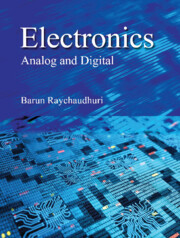Book contents
Summary
The operational amplifier, abbreviated as op-amp is an amplifier circuit comprised of active and passive components. It has high voltage gain, high input impedance, and wide range of frequency of input signal that it can handle. The most remarkable feature is that the op-amp can be used for the purpose of numerical computations, the numbers being represented by the input and output voltage values. This chapter brings together the basic properties of the op-amp and the most popular circuits constructed with it, such as inverting and noninverting amplifiers, adder, differentiator, integrator, active filter, comparator, Schmitt trigger, and logarithmic amplifier. Also some novel applications of op-amp, such as equation solving and waveform generating are introduced.
A Review on Amplifiers
In Chapters 5 through 10, we have come across different types of amplifiers made of bipolar junction transistors or field-effect transistors. Now we are quite familiar with the fact that the same device may not be suitable for voltage, current, and power amplification and at all frequencies of the input signal. In this chapter, we are about to start a new type of high gain voltage amplifier, known as operational amplifier, abbreviated as op-amp, which is made up of a number of transistors, either bipolar or field-effect or both, combined in a circuit. In this occasion, it may be relevant to have a quick recapitulation on the overall features of a typical amplifier.
Whatever may be the actual circuit configuration, an amplifier can be considered as an electronic circuit comprising one or more active device producing a magnified replica of the input voltage or current. In general, an amplifier has the following properties.
(i) The output signal has generally the same frequency and waveform as that of the input signal. If not, it is a special form of amplifier, known as oscillator or waveform generator.
(ii) The output amplitude is mostly different from the input amplitude and in maximum cases, the former is increased. Sometimes the output amplitude may decrease also when the circuit is called attenuator.
(iii) The phase of the output waveform may or may not change with respect to the input depending on the circuit operation and device property.
(iv) Each amplifier has a certain range of frequency for the input signal over which it can exhibit its properties.
- Type
- Chapter
- Information
- Electronics , pp. 362 - 431Publisher: Cambridge University PressPrint publication year: 2023



